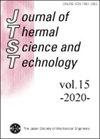Analysis and control of vapor bubble growth inside solid-state nanopores
IF 1.2
4区 工程技术
Q3 THERMODYNAMICS
引用次数: 4
Abstract
The increasing demands of computational power have accelerated the development of 3D circuits in the semiconductor industry. To resolve the accompanying thermal issues, two-phase microchannel heat exchangers using have emerged as one of the promising solutions for cooling purposes. However, the direct boiling in microchannels and rapid bubble growth give rise to highly unstable heat flux on the channel walls. In this regard, it is hence desired to control the supply of vapor bubbles for the elimination of the instability. In this research, we investigate a controllable bubble generation technique, which is capable of periodically producing bubble seeds at the sub-micron scale. These nanobubbles were generated in a solid-state nanopore filled with a highly concentrated electrolyte solution. As an external electric field was applied, the localized Joule heating inside the nanopore initiated the homogeneous bubble nucleation. The bubble dynamics was analyzed by measuring the ionic current variation through the nanopore during the bubble nucleation and growth. Meanwhile, we theoretically examined the bubble growth and collapse inside the nanopore by a moving boundary model. In both approaches, we demonstrated that by altering the pore size, the available sensible heat for the bubble growth can be manipulated, thereby offering the controllability of the bubble size. This unique characteristic renders nanopores suitable as a nanobubble emitter for microchannel heat exchangers, paving the way for the next generation microelectronic cooling applications.固态纳米孔内气泡生长的分析与控制
对计算能力日益增长的需求加速了半导体行业三维电路的发展。为了解决伴随而来的热问题,采用两相微通道热交换器作为冷却目的的有前途的解决方案之一。然而,微通道内的直接沸腾和气泡的快速生长导致通道壁上的热流密度极不稳定。在这方面,因此需要控制蒸汽泡的供应,以消除不稳定性。在本研究中,我们研究了一种可控的气泡产生技术,该技术能够在亚微米尺度上周期性地产生气泡种子。这些纳米气泡是在充满高浓度电解质溶液的固态纳米孔中产生的。外加电场作用下,纳米孔内局部焦耳加热引发均匀气泡成核。通过测量气泡成核和生长过程中通过纳米孔的离子电流变化来分析气泡动力学。同时,我们通过移动边界模型从理论上考察了纳米孔内气泡的生长和破裂。在这两种方法中,我们都证明了通过改变孔径,可以控制气泡生长的可用感热,从而提供气泡尺寸的可控性。这种独特的特性使得纳米孔适合作为微通道热交换器的纳米气泡发射器,为下一代微电子冷却应用铺平了道路。
本文章由计算机程序翻译,如有差异,请以英文原文为准。
求助全文
约1分钟内获得全文
求助全文
来源期刊
CiteScore
2.30
自引率
8.30%
发文量
0
审稿时长
5 months
期刊介绍:
JTST covers a variety of fields in thermal engineering including heat and mass transfer, thermodynamics, combustion, bio-heat transfer, micro- and macro-scale transport phenomena and practical thermal problems in industrial applications.

 求助内容:
求助内容: 应助结果提醒方式:
应助结果提醒方式:


